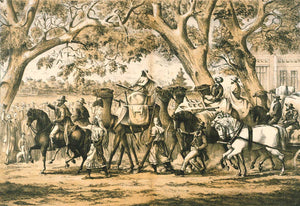The Unsung Heroes: Camels in the Burke and Wills Expedition
In the annals of exploration history, the Burke and Wills expedition stands out as one of the most ambitious but ill-fated ventures into the Australian outback. Led by Robert O'Hara Burke and William John Wills, this expedition aimed to traverse the continent from south to north in the mid-19th century. While the expedition is often remembered for its tragic outcome, one element that played a crucial role in its initial stages was the use of camels.

Camels in Australia:
The introduction of camels to Australia was a strategic decision that significantly influenced the success of the Burke and Wills expedition. Camels were brought to the continent in the mid-19th century as they were well-suited to the harsh and arid conditions of the Australian outback. These resilient creatures became the unsung heroes of the expedition, providing vital transportation, carrying supplies, and facilitating the explorers' journey through the unforgiving landscape.

‘Memorandum of the Start of the Exploring Expedition’ (1860)
by Nicholas Chevalier.
Transportation and Exploration:
One of the primary challenges facing the expedition was the vast and inhospitable terrain of the Australian interior. Traditional transportation methods were ill-suited for this harsh environment, leading Burke to employ camels as pack animals. Camels could carry heavy loads across the arid deserts and semi-arid regions, allowing the expedition to transport essential supplies, equipment, and provisions.
Camels proved invaluable in crossing the challenging terrain, particularly the sandy deserts and dry riverbeds. Their ability to endure long periods without water and carry heavy loads made them indispensable for exploration in regions where horses and other pack animals struggled.

Supplies and Survival:
Survival in the Australian outback required careful planning and resource management. Camels played a pivotal role in ensuring the expedition's survival by transporting essential supplies such as food, water, and equipment. Their ability to cover long distances without requiring frequent stops for water replenishment allowed the expedition to venture deeper into unexplored territories.
Furthermore, camels' adaptability to a diet of native vegetation helped sustain the expedition in areas where traditional livestock might have struggled to find sufficient nourishment. This unique capability allowed the explorers to traverse remote regions with greater ease.
Legacy and Impact:
Despite the tragic end of the Burke and Wills expedition, the role of camels in its early stages remains a significant aspect of Australian exploration history. The use of camels as pack animals opened up new possibilities for inland exploration, shaping subsequent expeditions and influencing transportation methods in the challenging Australian outback.

The Burke and Wills expedition, though marred by misfortune, sheds light on the crucial role that camels played in the exploration of the Australian interior. These resilient creatures, with their ability to endure harsh conditions and carry heavy loads, were instrumental in the initial stages of the expedition. The legacy of camels in Australian exploration endures as a testament to their adaptability and contribution to overcoming the challenges of the vast and challenging outback.

